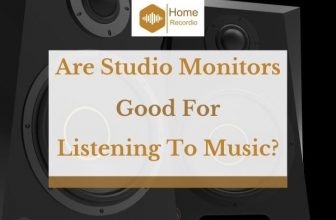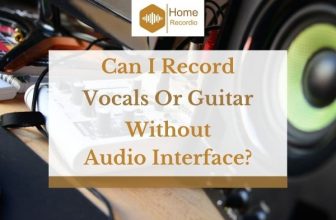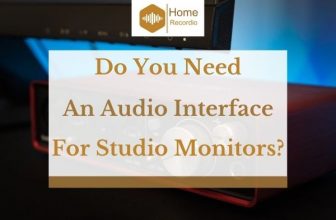Ableton vs. Garageband – A Side by Side Detailed Comparison
Ableton vs. Garageband, which one of these two DAWs is better?
In this side-by-side comparison I will cover the free versions only.
I will go over several important factors. These should also be the things that you should pay attention to as well.
How each system performs in each category is the key. You can use it to determine which one is the best DAW for you.
Table of Contents
Factors to Consider
Let’s go over each of these factors in the discussion below:
Recording
Every DAW should have the capability to record vocals and instruments. This is one of the most important features that you should look into.
Remember that you will eventually incorporate live recordings in your work.
Audio Mixing
Audio mixing refers to the optimized and efficient method of combining recordings.
The audio tracks that you have recorded will be mixed to create a stereo, surround sound, or mono sound product.
During the mixing process, the different elements of each audio track will be adjusted.
For instance, the volume of one track may be lowered to serve as some kind of background.
The compression and equalization are also adjusted for each track as well.
Number of Tracks
An audio track refers to MIDI clips, audio recordings, or music and sound tracks that you can combine.
Different DAWs will usually support a different number of tracks that you can work on.
Stock Instrument and Sounds Plugins
The quality of stock sounds and plugins will affect the quality of your music.
Some DAWs have better switching between these sounds for live performances.
On the other hand, some DAWs are better suited for recording using these plugins.
MIDI Composition
MIDI stands for Musical Instrument Digital Interface. It is basically sound data that is used by computers, samplers, synthesizers and so on.
Think of it as the way electronic devices that control and make sound connect with one another.
MIDI files can be used in a DAW to store relevant information as well. It can store music data such as the timing, type of instrument, and music notation.
Some DAWs have better MIDI tracks than others. This is important for musical composers who produce EDM music and hip-hop.
Audio Editing and Manipulation
A really important feature that you should consider is the audio editing and manipulation capability of a DAW.
Does it allow you to easily edit imported or recorded music audio? Can it do both?
Does it allow you to stretch sections of the audio? Does it allow you to easily zoom into any particular section of a recording?
Another important thing to look out for is if editing creates any distortions on the tracks.
Automation
Some DAWs are a lot better at automating the sound production process. DAWs allow you to preprogram certain steps in your very own production process.
That will make things more convenient for you as a composer.
Automation allows you to change the effects and the dynamics of your music.
For instance, you can automate the volume, sound effects, panning, and instrument sounds.
Required Processing Power
Some DAWs require more power from your computer’s CPU while others are perfectly fine with low-end to mid-range computers.
The type of DAW that you should pick must match the computer that you’re using.
I don’t recommend that you buy a brand new computer because you want to use a more powerful DAW.
You should work with what you have first and try the free versions first.
If you feel that a DAW is better suited for you and computer can handle it then use it. As you gain more experience with mixing and recording, plan on getting upgrades.
I suggest that you start saving up money for a more expensive setup at that point.
Ableton vs. Garageband – Comparing the Two DAWs
In this section I will compare Ableton vs. Garageband according to the different criteria mentioned above.
I will highlight the pros and cons of each DAW. Both Garageband and Ableton gain the upper hand in each of the different factors.
Recording Capability
Ableton
Ableton Live makes it very easy to record instruments played live. This is actually one of the easiest DAWs that I have tried.
And the tracks it produces are pretty good indeed. To start recording on this DAW all you need to do is to click the Record Arm.
After that, you’re all set to start recording.
The big downside is that you are limited in the number of tracks that you can record.
Take note that Ableton Live only allows you to mix a total of 8 tracks. You can either record 8 instruments or fewer.
You may also record certain parts of the music on a separate track. For example, you can record a second guitar part on a free track.
You can use it for the guitar solo, backing vocals, and maybe a couple layers of synth.
Garageband
You can say that Garageband has everything that Ableton offers minus the downsides. It allows you to work with an unlimited number of tracks that you can record.
This DAW also has better features for live recording and performance. It’s very easy to record multiple takes in Garageband.
You can take advantage of different versions of the playback. After that, you can just choose from your collection of recordings and mix them as you please.
The Verdict
When it comes to recording instruments live, Garageband has the advantage over Ableton. This is due to its advanced features for live performances and recording.
Audio Mixing
Ableton
This DAW provides you with a total of 14 effects to work and play with.
That is already enough for beginners but as you gain experience you will eventually ask for more.
Since you’re using the free version, you can only use a somewhat standard audio effects rack.
It also comes with chorus, compressor, simple delay, reverb, and an auto filter.
But if you’re looking to create a unique mix of sounds, then you will definitely feel that it is lacking.
Ableton is also missing an EQ plugin. An equalizer is essential for good sound mixing. You will need certain instruments to sound a lot more prominent than others.
For instance, some parts of the music may require you to make the drum section a bit quieter. After that you can increase the volume on the high pitch vocals.
You will have to upgrade your DAW version to the Suite or Standard Edition to get that EQ plugin. It’s either that or you install a third-party EQ plugin.
As a bit of saving grace, it allows you to group multiple tracks together and then mix them.
Garageband
Ableton vs. Garageband mixing features, I can say that Garageband offers a bit more.
The effects are just a bit difficult to find because they’re categorized under different headings.
You will have to look for them in under different categories like:
- Modulation
- Reverb
- EQ
- Dynamics
- Distortion
- Delays
In short, you have to know exactly what you’re looking for.
Note that there will be multiple effects under each of these categories. For instance, if you go to distortion, you will find different types of distortion effects.
This is a better option if you already have more experience with mixing music.
Your tracks will sound more professional given the fact that you have more tools to work with.
Another advantage of this DAW is that it allows you to add more third party effects and plugins.
However, as a bit of a caveat, this will require more computing power from your computer.
The Verdict
We can see from the specs of these two DAWs, both are pretty much on the same level.
Remember that both Ableton Live and Garageband are the free versions of their respective full DAWs.
Let’s set the user expectations here. Don’t compare these two to their premium versions.
As far as mixing music is concerned, you can get pretty much the basic functionalities that you need.
Number of Tracks
Ableton
Ableton Live supports 8 MIDI and other types of audio tracks. Again, this is good for beginners and newbies.
But experienced music producers will find this rather limiting. There isn’t much room for dynamic changes and layering.
If you’re a beginner, then I would suggest that you use Ableton since it is more beginner-friendly.
You can switch to the standard version or just switch to Garageband for more options.
Garageband
Garageband on the other hand supports up to 255 tracks. That is more than enough tracks to create unique and fascinating music in any genre.
However, if you’re a professional music producer, you might need a bit more. This is especially true if you’re working on multi-track versions of several songs.
The Verdict
Garageband is the clear winning in this department since it lets you use more tracks.
However, remember that both of these DAWs have limitations as to the number of tracks.
Stock Instrument and Sounds Plugins
Ableton
This DAW only gives you four stock plugins to begin with. They include the instrument rack, impulse, sampler, and drum rack.
This is the stripped down version of the sampler set from the Standard and Suite versions.
It’s basically just the very basics that you will need to make music samples and instrument tracks.
The instrument and drum racks have plenty of sound clips which are quite useful for recordings and live performances.
They are very useful for layering sounds and switching from one sound to the other. You get a total of 1,500 sounds bites when you go for Ableton.
Garageband
Garageband offers more stock sounds when you install it on your computer.
It has more than a hundred different categories of sounds and instruments, which includes the following:
- Synthesizers
- Orchestral instruments
- Organs
- Guitars
- Pianos
- Vintage EPs
Each of these categories will have a plethora of sounds and instruments within it.
You get a total of 25 gigabytes of sound data to play around with. What’s the catch? You have to download it from their official website.
And because of the sheer size of this data, it will take a while to complete.
The Verdict
Garageband has more stock instruments and sound plugins.
Note however, that these plugins need to be downloaded before you can use them. The total file size of the plugins and instruments is huge.
MIDI Composition
Ableton
Ableton Live is a great DAW when it comes to MIDI composition.
I think it trumps Garageband by a longshot. It integrates a lot better with many of the available MIDI controllers out there.
There are also a lot of compatible MIDI controllers for this DAW. All you have to do is to plug it in and then it maps to the controls.
The controls in Ableton are intuitive and easier to navigate compared to Garageband.
Now, the only downside is that there are only 8 MIDI effects in Ableton.
But I think this set is okay. It already includes velocity, pitch, note length, and the Arpegiattor.
You can already combine these effects to create unique MIDI tracks. It’s great for beginners because they won’t be distracted by a plethora of options.
You can focus on your creative juices without having to worry about which effect to use.
Garageband
The surprising thing about this for me is that Garageband doesn’t come with MIDI effects. It does allow you to use a MIDI controller but Ableton integrates much better.
With Garageband, you need to manually map the controllers, which can be a hassle.
The Verdict
When it comes to MIDI composition, Ableton has the upper hand because it integrates third party MIDI controllers better.
On top of that, Garageband doesn’t come with MIDI effects.
Audio Editing and Manipulation
Ableton
Ableton Live has very easy audio editing features. You can use them on the tracks that you recorded and also on those that you imported.
It allows you to zoom into the sections of your composition.
You can easily select a section, modify it, and even delete it if needed. It is also a lot easier to clean out samples using Ableton. Deleting unnecessary parts of your tracks is really easy as well.
This DAW also has the warping feature. This feature allows you to stretch sections of your tracks without affecting the other audio tracks.
You can speed up and slow down track sections without getting any type of distortion in the output.
This is due to the complex algorithms that this DAW uses for music data manipulation.
Garageband
Don’t get me wrong, but editing music in Garageband is also simple. It also allows you to delete sections of your tracks that you don’t need.
It can also time-stretch certain music tracks as well.
However, I have noticed that distortions can creep up when you use these editing features. It’s not as smooth compared to Ableton.
This DAW also doesn’t have a warping feature, which is a bit disappointing. Sometimes it won’t allow you to time-stretch certain parts of your audio.
A workaround that I have tried is by installing 3rd-party sampler plugins—but they’re not free.
The Verdict
In my honest opinion, I think Ableton Live is better at audio editing and manipulation.
I like the advanced editing features that blow away what Garageband has to offer.
You don’t need to install any third-party plugins to get these editing features.
Automation
Ableton
To automate in Ableton, all you need is to toggle it on or off with just one click.
Let’s say you want to automate the pan on a particular track, the first step is to toggle automation to on. After that, click on that track and select a section or parameter on it.
After that, click on the Pan button and from there you can edit as needed. It’s that easy.
Garageband
Garageband pretty much has the same automation features as Ableton.
The Verdict
Ableton vs. Garageband – which of these two DAWs is better when it comes to automation?
I think it’s a tie. It’s very easy to automate tasks using both of them.
Required Processing Power
Ableton
They don’t call it Ableton Live Lite for nothing.
This DAW doesn’t require a lot of processing power, which is great for people who have slow computers.
Garageband
Garageband is also easy on CPU power.
However, it may require a little more graphics power because it uses a more graphical interface.
The Verdict
Both Ableton and Garageband work well with slower computers. They don’t require a lot of processing power.
On that note, Garageband may require a bit more from your GPU due to the graphical interface.
Which is Better, Ableton vs. Garageband?
If you’re a beginner and you need a simple DAW that won’t be that confusing, then I recommend Ableton Live Lite for you.
However, if you’re more experienced and more technical, then I recommend Garageband.
If you tend to record more live performances or work with more instruments, then Garageband is the better option.
But if you’re looking for better and easier editing features, then Ableton is the way to go.





